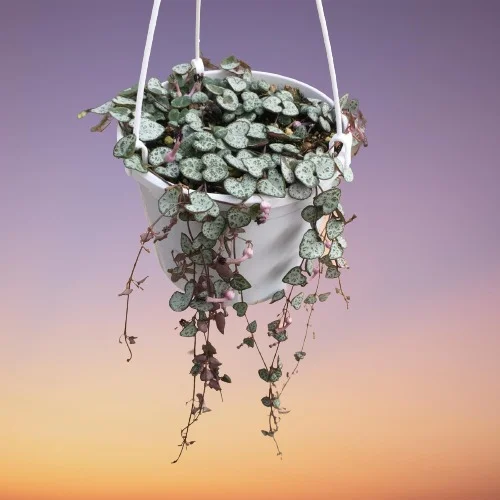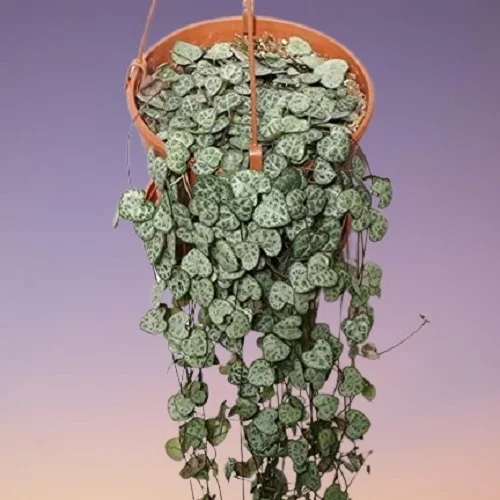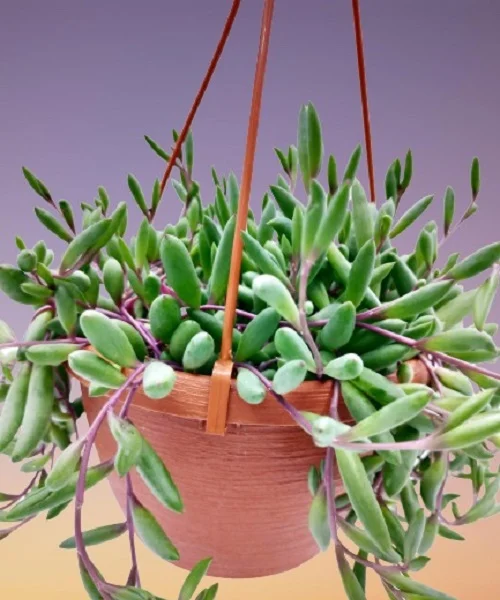11 Causes of String of Hearts Plant Yellow Leaves and their Remedies
Some links in this post may be affiliate links
String of Hearts Plant leaves may yellow due to incorrect watering, soggy soil, low light, temperature stress, nutrients deficiency, being pot-bound, root-rot, diseases or pests among others.
String of Hearts Plant flourishes in bright indirect light (filtered light), warmth of 16-250C, humidity of 50-55% and moderately moist, rich, well-drained, succulents potting soils coupled with monthly feeding in the growing season. Learn how to grow and care for String of Hearts Plant (Ceropegia woodii).
When these conditions are not met, String of Hearts Plant's eye-catching, fleshy, grey-green leaves with a marbled pattern may begin to turn yellow. Following are 11 reasons why the leaves on your String of Hearts Plant are yellowing and how to fix them.

11 Reasons String of Hearts Plant Leaves are Turning Yellow & Solutions
1. Too Little Light
Adequate light is needed for making food that is required for energy and growth. Insufficient light means that the plant cannot make enough food for energy and growth. In an attempt to save energy, the leaves turn yellow and begin to drop leaves. This way, the plant saves the available energy for the vital functions to keep alive.
How to fix it
Position your String of Hearts Plant in a brighter spot where it will receive bright indirect light or instal grow lights if the natural lighting is not adequate.
Regularly turn the pot to ensure that the plant receives enough light on all sides for uniform growth as well as prevent leggy growth.
2. Nutrients deficiency
Overfeeding your String of Hearts Plant will cause the roots to die due to fertilizer burn. Therefore, they cannot take up nutrients and water required for photosynthesis, thus the leaves begin to turn yellow.
If the plant is underfed, it is not getting enough nutrients needed for growth, therefore, the leaves begin to turn yellow and eventually die.
How to fix it
Feed your String of Hearts Plant monthly in spring and summer with a balanced, liquid fertilizer. Take care not to overfeed by following the instructions on the label of the plant food.
Regularly flush out accumulated salts from the soil by running a stream of water through the soil until it comes out through the drainage holes and repeat the process several times.
3. Pest infestations
String of Hearts Plant is prone to spider mites, aphids and scales infestations. These sap-sucking insects attack the new growth from where they suck the plant sap and will cause wilting, yellowing and leaf drop.
How to fix it
Maintain your String of Hearts Plant well pruned by removing dead foliage to reduce pest infestations.
Regularly inspect the plant for the pests and take timely control measures.
Treat the affected plant with neem oil and insecticidal soap as recommended by the manufacturers.

4. Poor soil quality
Poor quality soil does not drain easily and will become compacted or soggy which will lead to reduced growth, yellowing of leaves and death.
How to fix it
Grow your String of Hearts Plant in rich, well-drained soils which will not get soggy while providing the required nutrients. Most Cactus and succulents mixes are perfect for the plant.
5. Root-rot disease
String of Hearts Plant is prone to root-rot which is prevalent in soggy soil. The disease is characterized by wilted, discolored leaves, corky swellings under the leaves, yellow and dropping leaves.
Soggy soil reduces oxygen concentration in the soil which causes the roots to die. Once the roots die, they cannot take up water and nutrients to the leaves. Therefore, the leaves begin to wilt, turn yellow and eventually drop.
How to fix it
Slip the String of Hearts Plant out of its pot and inspect the roots.
Brown-black mushy roots indicate root-rot, trim them off and treat the healthy roots with a copper-based fungicidal solution. Ensure to follow the manufacturer's instructions.
Disinfect the pot with the fungicidal solution or use a fresh pot to repot the plant in fresh, free-draining soil.
Keep the plant dry for some time before resuming watering.
Ensure that the pot has a drainage hole and that the soil is free-draining to prevent it from getting soggy in the future.
6. Being Pot-bound
String of Hearts Plant requires to be repotted at the beginning of the growing season when it becomes pot-bound. If the plant is pot-bound the leaves begins to wilt, yellow and eventually die.
This is because when it pot-bound, the roots have filled the pot, there is very little soil to hold water when the plant is watered. This means the plant cannot take up water to the leaves for photosynthesis and thus it cannot make enough food for growth and the leaves begin to turn yellow.
How to fix it
Check the bottom of the pot. If the roots are growing through the drainage hole, repot your String of Hearts Plant into a pot one size larger than the current one.
Ensure that the pot has a drainage hole and that the soil is free-draining to prevent waterlogging.
Use a shallow rather than deep pot as the plant has a small (shallow) root system. A clay pot is preferable as it is porous, thus allows the soil to dry out faster. Check out these succulents pots available on Amazon.

7. Soggy soil
Soggy soil leads to the death of the roots due to lack of oxygen which implies that the plant cannot take up water, therefore, it cannot make food for growth and energy.
Without enough food for growth and in a bid to save energy, the plant begins to die which begins from the leaves turning yellow, brown and eventually die.
How to fix it
Use a pot that has a drainage hole and loose, well-draining soil to prevent waterlogging.
8. Incorrect watering
Underwatering your String of Hearts Plant means that there is too little moisture in the soil for the plant to take up to the leaves for photosynthesis, to make food for growth of the plant.
Overwatering results in soggy soil which leads to the death of the roots due to lack of oxygen. When the roots die, the plant cannot take up water, therefore, it cannot make food for growth and energy.
The lack of adequate food for growth and other processes in the plant will cause the plant to begin to die from the leaves which turn yellow, brown and eventually drop.
How to fix it
Do not water on a schedule. Water your String of Hearts Plant when the top 2-3 inches of soil dry out and never allow the soil to dry out completely.
9. Temperature stress
If the temperatures are not right, it will adversely affect growth of your plant. Too low temperatures will lead to reduced (stunted) growth and as such the leaves begin to turn yellow and die to save energy for the plant.
Very high temperatures will cause excessive loss of water which will lead to dehydration, wilting and yellowing leaves and leaf drop.
How to fix it
Place your String of Hearts Plant away from sources of drafts like drafty winds, AC vents, open doors, hot surfaces, hot air vents and others to maintain a warmth of 16-250C.
10. Repotting shock
Repotting your String of Hearts Plant may cause it some shock which may lead to some leaves wilting and turning yellow before it can adjust the new growing conditions.
How to fix it
To minimize repotting shock, water the plant thoroughly one day before repotting as a well hydrated plant experiences less shock than a dry plant.
Avoid making too many changes at once. For instance, after repotting, maintain the plant in the same spot until it is well established before moving it to a new location.
11. Aging
As your String of Hearts Plant leaves mature, the older leaves turn yellow and die. Therefore, do not be alarmed, if a few leaves turn yellow as this is a natural process.
You liked it? Share on social media.
Related Content
Amazon Associates Disclosure
Homeplantsguide.com is a participant in the Amazon Services LLC Associates Program, an affiliate advertising program designed to provide a means for sites to earn advertising fees by advertising and linking to amazon.com.



